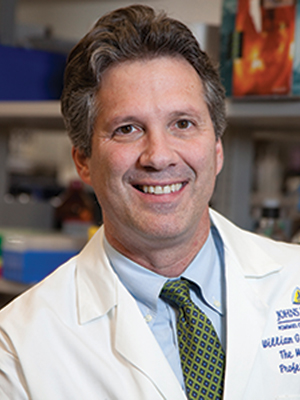
William G. Nelson, MD, PhD Photo by Joe Rubino
PALLIATIVE CARE, derived from the Latin word “pallium” for cloak, addresses symptoms and distress accompanying serious illnesses. The field is emerging as a vital medical specialty in the multidisciplinary treatment of cancer.
While the notion that physicians should seek both to cure disease and to alleviate suffering has underpinned medical practice for centuries, specialized palliative medicine grew out of the modern hospice movement launched in the 1960s by Cicely Saunders, an English nurse, social worker, physician and writer. Though hospices had long served the impoverished terminally ill, Saunders’ establishment in 1967 of St. Christopher’s Hospice in London created a site for expert pain and symptom relief, psychosocial and spiritual care, clinical research and teaching. Hospices based on this model grew quickly across the United Kingdom, the United States and the world.
Hospice care and palliative care share similar goals in providing relief of pain and other symptoms, but they remain distinct: Hospice care provides relief when life-threatening diseases cannot be cured or controlled, whereas palliative care can be applied whether or not illnesses are treated to be cured. For cancer patients, hospice care can aid the terminally ill who have no treatment options, but palliative care can potentially improve quality of life for anyone with the disease, beginning at diagnosis.
Two recent randomized clinical trials illustrate the benefits of palliative care for cancer patients. One examined the contribution of formal palliative care to patients undergoing hematopoietic stem cell transplantation. Patients receiving palliative care as part of the stem cell transplantation program reported significantly smaller decreases in quality of life and fewer symptoms of depression and anxiety than did patients who were provided with palliative care only upon request. The second clinical trial tested the benefit of introducing palliative care as soon as possible after a diagnosis of advanced non-small cell lung cancer. In this study, as in the stem cell transplantation study, patients receiving formal palliative care interventions reported better quality of life and less depression than those who did not. More remarkably, patients receiving early palliative care exhibited longer overall survival.
Specialized palliative care has grown rapidly over the past two decades. Between 1998 and 2013, the proportion of U.S. hospitals with 50 beds or more having formal palliative care programs has increased from 15 to 67 percent. In 2006, Hospice and Palliative Medicine became a formal medical subspecialty recognized by the American Board of Medical Specialties. The American Academy of Hospice and Palliative Medicine now boasts some 5,000 members.
Nonetheless, with nearly 1.7 million new cancer cases diagnosed last year in the U.S., there are not enough palliative care specialists to provide all the consultation and management services needed. This means these specialists will need to work with multidisciplinary cancer care teams to fully integrate palliative care into cancer treatment plans beginning at diagnosis. Surgical, medical and radiation oncologists, along with oncology nurses and social workers, will need training in the key principles and tactics of palliative care delivery. Palliative care specialists can then provide formal consultation for patients who require additional attention for symptom management and other challenges.
Better access to expert palliative care for all cancer patients must be a priority. Better “cloaking” of cancer symptoms will benefit all who confront cancer—preserving dignity, quality of life and humanity.
Cancer Today magazine is free to cancer patients, survivors and caregivers who live in the U.S. Subscribe here to receive four issues per year.




